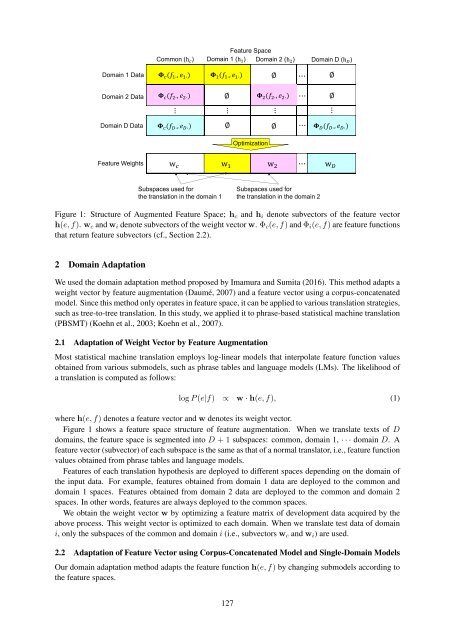December 11-16 2016 Osaka Japan
W16-46
W16-46
You also want an ePaper? Increase the reach of your titles
YUMPU automatically turns print PDFs into web optimized ePapers that Google loves.
Feature Space<br />
Common (h ) Domain 1 (h ) Domain 2 (h ) Domain D (h )<br />
Domain 1 Data<br />
( ·, ·)<br />
( ·, ·)<br />
∅<br />
⋯<br />
∅<br />
Domain 2 Data<br />
Domain D Data<br />
( ·, ·) ∅ ( ·, ·) ⋯ ∅<br />
⋮ ⋮ ⋮ ⋮<br />
( ·, ·) ∅ ∅ ⋯ ( ·, ·)<br />
Optimization<br />
Feature Weights w w w ⋯ w <br />
Subspaces used for<br />
the translation in the domain 1<br />
Subspaces used for<br />
the translation in the domain 2<br />
Figure 1: Structure of Augmented Feature Space; h c and h i denote subvectors of the feature vector<br />
h(e, f). w c and w i denote subvectors of the weight vector w. Φ c (e, f) and Φ i (e, f) are feature functions<br />
that return feature subvectors (cf., Section 2.2).<br />
2 Domain Adaptation<br />
We used the domain adaptation method proposed by Imamura and Sumita (20<strong>16</strong>). This method adapts a<br />
weight vector by feature augmentation (Daumé, 2007) and a feature vector using a corpus-concatenated<br />
model. Since this method only operates in feature space, it can be applied to various translation strategies,<br />
such as tree-to-tree translation. In this study, we applied it to phrase-based statistical machine translation<br />
(PBSMT) (Koehn et al., 2003; Koehn et al., 2007).<br />
2.1 Adaptation of Weight Vector by Feature Augmentation<br />
Most statistical machine translation employs log-linear models that interpolate feature function values<br />
obtained from various submodels, such as phrase tables and language models (LMs). The likelihood of<br />
a translation is computed as follows:<br />
log P (e|f) ∝ w · h(e, f), (1)<br />
where h(e, f) denotes a feature vector and w denotes its weight vector.<br />
Figure 1 shows a feature space structure of feature augmentation. When we translate texts of D<br />
domains, the feature space is segmented into D + 1 subspaces: common, domain 1, · · · domain D. A<br />
feature vector (subvector) of each subspace is the same as that of a normal translator, i.e., feature function<br />
values obtained from phrase tables and language models.<br />
Features of each translation hypothesis are deployed to different spaces depending on the domain of<br />
the input data. For example, features obtained from domain 1 data are deployed to the common and<br />
domain 1 spaces. Features obtained from domain 2 data are deployed to the common and domain 2<br />
spaces. In other words, features are always deployed to the common spaces.<br />
We obtain the weight vector w by optimizing a feature matrix of development data acquired by the<br />
above process. This weight vector is optimized to each domain. When we translate test data of domain<br />
i, only the subspaces of the common and domain i (i.e., subvectors w c and w i ) are used.<br />
2.2 Adaptation of Feature Vector using Corpus-Concatenated Model and Single-Domain Models<br />
Our domain adaptation method adapts the feature function h(e, f) by changing submodels according to<br />
the feature spaces.<br />
127



